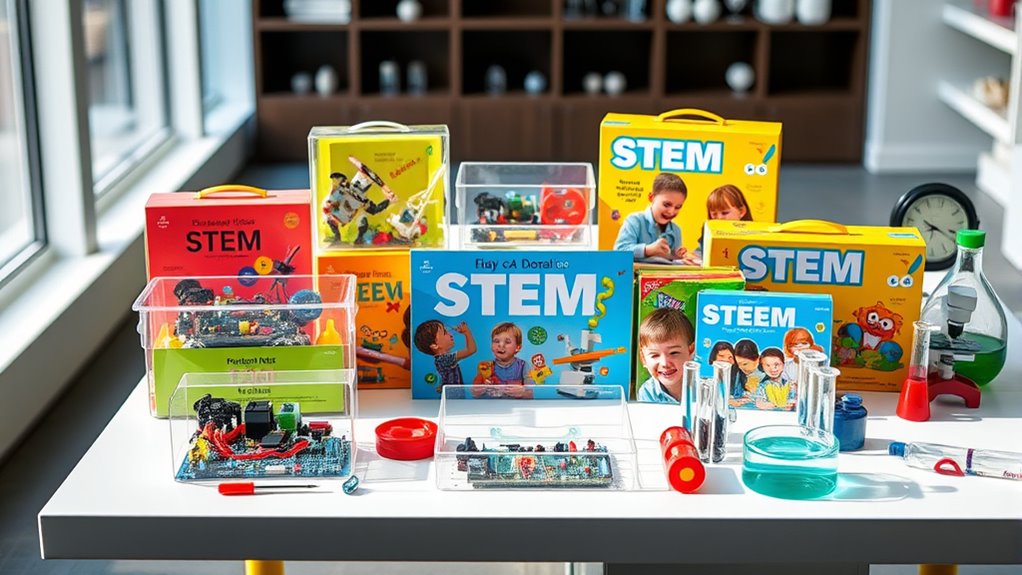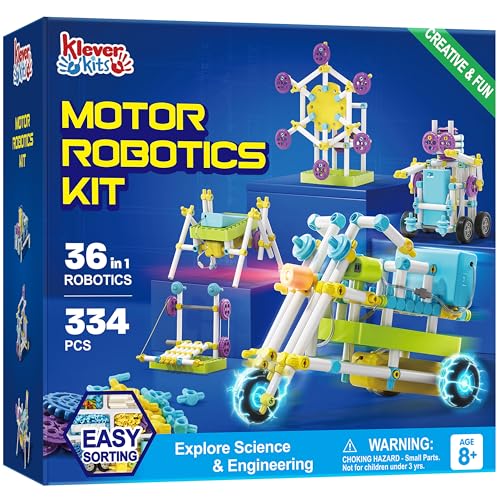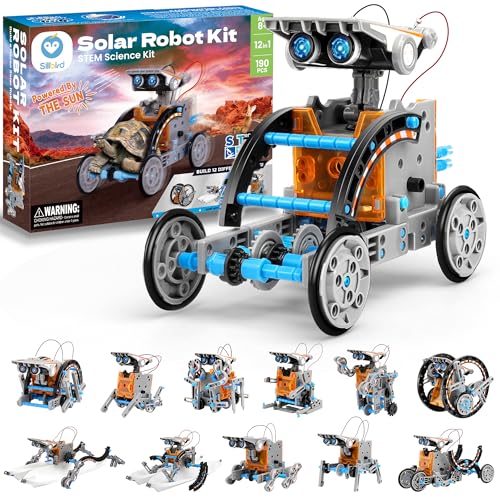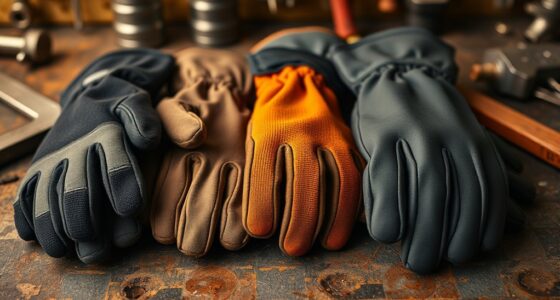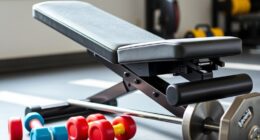If you’re looking for the best STEM kits that make learning fun and engaging, I’ve got some great suggestions. From simple science experiments like the National Geographic Earth Science Kit to building electronic circuits with Snap Circuits Jr., there’s something for every age and interest. Robotics kits like Klever’s 36-in-1 Motor Robots or solar-powered models also boost creativity and problem-solving. Keep exploring to find the perfect fit that sparks curiosity and keeps kids excited about STEM!
Key Takeaways
- These kits cover a wide range of STEM topics, including electronics, robotics, earth sciences, and creative building.
- They feature engaging, hands-on activities suitable for different age groups, fostering curiosity and active learning.
- Many kits include detailed instructions, reusable components, and safety features to ensure a safe and enjoyable experience.
- Popular options like Snap Circuits, Klever Kits, and Sillbird Solar Robots promote problem-solving and critical thinking skills.
- They are designed for home, school, or educational use, making learning fun and accessible for children of various ages.
Snap Circuits Jr. SC-100 Electronics Exploration Kit
If you’re looking for a STEM kit that makes learning electrical engineering both safe and fun for kids aged 8 and up, the Snap Circuits Jr. SC-100 Electronics Exploration Kit is a perfect choice. It offers over 100 projects, including flying saucers and alarms, with a full-color manual to guide young learners. The kit includes 28 color-coded, snap-together parts that require no soldering, making setup quick and easy. It promotes hands-on learning, helping kids develop circuitry skills and explore electrical concepts. As an educational gift, it’s engaging, expandable, and recognized for its quality and impact, making STEM learning enjoyable and accessible.
Best For: children aged 8 and up who are interested in exploring electrical engineering concepts in a safe, hands-on, and engaging way.
Pros:
- Over 100 projects that promote STEM learning and creativity
- No soldering or tools required, making setup simple and safe for kids
- Includes a comprehensive, full-color manual and 28 color-coded parts for easy building
Cons:
- Requires batteries (not included) for operation
- Limited to 28 parts, which may restrict some more advanced project expansions without additional kits
- Some users may find the number of projects overwhelming for beginners to complete quickly
Klever Kits 36-in-1 Motor Robotic Kits for Kids
The Klever Kits 36-in-1 Motor Robotic Kits stands out as an excellent choice for young builders aged 8 to 13 who love hands-on learning and creative exploration. With the ability to build 36 different robots, including walking machines and racing cars, it promotes STEM skills through engaging projects. All parts are neatly organized in a tray, making setup and cleanup easy. The kit includes a detailed instruction booklet and video tutorials, boosting confidence and independence. Perfect for solo or group play, it encourages problem-solving, teamwork, and safe, screen-free fun—making it a versatile and educational gift for curious kids.
Best For: young children aged 8 to 13 who enjoy hands-on STEM learning, creative building, and screen-free play.
Pros:
- Encourages problem-solving, logical thinking, and STEM skills through engaging projects
- All parts are organized in a tray for easy setup, cleanup, and part retrieval
- Includes detailed instructions and video tutorials to boost confidence and independence
Cons:
- May require adult supervision for younger children during assembly
- Limited to a maximum of 36 robot models, which could feel restrictive for advanced builders
- Some parts may be small and pose a choking hazard for very young children
NATIONAL GEOGRAPHIC Earth Science Kit with 100+ Experiments
For young aspiring scientists who love hands-on learning, the NATIONAL GEOGRAPHIC Earth Science Kit offers an impressive collection of over 100 experiments that make exploring our planet both fun and engaging. It includes 15 exciting activities like crystal growth and volcano eruptions, sparking curiosity and discovery. The kit provides all necessary materials, making setup quick and easy for independent exploration. It features 10 rock and mineral specimens, perfect for collection and study, stored in a handy case. Plus, with an extra guide offering 85+ experiments using household items, this award-winning kit encourages continuous learning and discovery beyond initial activities.
Best For: young science enthusiasts and educators seeking a comprehensive, hands-on earth science learning experience with engaging experiments and collectible specimens.
Pros:
- Extensive collection of over 100 experiments for varied learning opportunities
- Includes all necessary materials and a storage case for easy setup and organization
- Features rock and mineral specimens for hands-on collection and study
Cons:
- May require adult supervision for younger children during experiments
- Some experiments may need household items not included in the kit
- Larger in size, which might limit storage space for some users
Sillbird 12-in-1 Solar Robot Building Kit for Kids
The Sillbird 12-in-1 Solar Robot Building Kit stands out as an engaging choice for kids aged 8-13 who love hands-on projects and outdoor learning. I find it perfect for sparking curiosity about engineering and renewable energy, all while promoting screen-free fun. With 190 pieces, children can build 12 different models, from robots to cars, with varying complexity to match their growing skills. The upgraded larger solar panel ensures stronger power output, encouraging outdoor play and environmental awareness. Plus, the clear instructions make assembly easy, helping kids boost their confidence and fine motor skills through creative, educational building experiences.
Best For: kids aged 8-13 who enjoy hands-on engineering projects, outdoor learning, and exploring renewable energy through creative building activities.
Pros:
- Encourages STEM learning, problem-solving, and creativity through multiple build options.
- Powered by an upgraded solar panel, promoting environmental awareness and outdoor play.
- Includes clear, step-by-step instructions suitable for independent or collaborative building.
Cons:
- Limited to solar power, which may reduce playtime on cloudy days or indoors without artificial light.
- Some models may require adult supervision for younger children or beginners.
- Assembling all 12 models can be time-consuming, requiring patience and focus.
Poraxy 4-in-1 STEM Kits for Kids 8-13
If you’re looking for a versatile STEM kit that sparks creativity and learning for kids aged 8 to 13, Poraxy 4-in-1 STEM Kits stand out as an excellent choice. These kits include parts to build mini ferris wheels, carousels, fiber optic lamps, and star night lights, offering engaging projects for children. Designed for ages 6-14, they promote hands-on learning in electrical engineering, circuit building, and mechanical assembly. Made from high-quality, laser-cut wooden pieces, they’re easy to assemble and encourage personalization through painting and decorating. With positive reviews and high ratings, these kits are perfect for fostering problem-solving, imagination, and STEM skills in young learners.
Best For: children aged 8 to 13 who enjoy hands-on STEM learning, creative building, and educational projects that combine science, engineering, and artistic expression.
Pros:
- High-quality, laser-cut wooden pieces with smooth edges for easy assembly and durability
- Offers a variety of engaging projects including ferris wheels, carousels, fiber optic lamps, and star night lights to promote creativity and STEM skills
- Encourages personalization through painting and decorating, fostering imagination and fine motor development
Cons:
- Some users mention the need for adult supervision, especially for wiring and delicate parts
- Minor challenges with tight battery compartments or trimming excess pieces during assembly
- Materials may feel cheaper or less durable compared to more premium kits, which could affect longevity
60+ Science Experiment Kit for Kids Ages 5-8, STEM Educational Science Gifts
This science experiment kit is perfect for young kids aged 5 to 8 who are enthusiastic to explore the world of STEM through hands-on activities. With over 60 experiments, including volcanic eruptions, dinosaur egg digging, and lava lamps, it keeps kids engaged and curious. All materials, tools, and safety goggles are included, along with easy-to-follow manuals for parent-assisted use. Designed to promote exploration, critical thinking, and problem-solving, this kit makes science fun and accessible. It’s ideal for home, school, or gifting, encouraging children to ask questions, observe, and investigate their surroundings while feeling like real scientists.
Best For: parents, teachers, and children aged 5-8 who want a fun, educational, and hands-on way to explore STEM concepts at home or in the classroom.
Pros:
- Includes over 60 engaging experiments to spark curiosity and learning.
- All materials and safety goggles included, making it easy and mess-free for young children.
- Well-illustrated manuals provide simple guidance for parent-assisted exploration and critical thinking development.
Cons:
- Suitable primarily for children aged 6 and up, so younger kids may need additional supervision.
- Limited to a weight of 1 pound, which might restrict some larger-scale experiments.
- Availability and prices may vary across stores, potentially affecting affordability or access.
Creativity for Kids Grow N Glow Terrarium Kit
Looking for a STEM kit that combines science, art, and responsibility in a fun, hands-on way? The Creativity for Kids Grow N Glow Terrarium Kit is perfect for kids 6 and up. It lets children create and decorate a mini ecosystem inside a mason jar, promoting learning about plant biology, soil, sunlight, and ecosystems. The kit includes real seeds, glow-in-the-dark accents, figurines, stickers, and decorative stones, encouraging creativity and environmental awareness. Kids can water, replant, and observe plant growth over two cycles, fostering patience and responsibility. With safe, reusable materials, it’s an engaging way to make science fun and accessible at home or school.
Best For: kids ages 6 and up who are interested in science, art, and nature, and enjoy hands-on, screen-free activities that promote responsibility and creativity.
Pros:
- Encourages STEM learning by teaching plant biology, ecosystems, and responsibility through real seed planting and replanting.
- Includes glow-in-the-dark accents and decorative figurines that make the activity engaging and visually appealing.
- Reusable design supports two planting cycles, offering ongoing educational value and fun.
Cons:
- Some users have noted a soil odor upon opening the kit, which may be unpleasant for sensitive children.
- Assembly might require adult supervision for younger children to ensure proper handling of materials.
- Limited to two planting cycles before needing additional supplies for continued growth.
UNGLINGA 150 Experiments Science Kits for Kids
The UNGLINGA 150 Experiments Science Kits for Kids stands out as an excellent choice for young aspiring scientists enthusiastic to explore a wide range of scientific topics. With 150 DIY projects covering earth sciences, chemistry, physics, and surface tension, it sparks curiosity and hands-on learning. The kit includes a clear, step-by-step manual and high-quality, kid-friendly tools, making experiments safe and easy to follow, often using household items. It encourages children to act as real scientists, fostering active participation and making science both fun and educational. Perfect for gifts or summer activities, it promotes problem-solving and scientific thinking while creating meaningful bonding moments.
Best For: parents, teachers, and children who want a comprehensive, safe, and engaging science learning experience through hands-on experiments.
Pros:
- Offers 150 diverse experiments covering multiple scientific fields, fostering broad scientific curiosity.
- Includes clear, step-by-step instructions and high-quality, kid-friendly tools for safe, easy use.
- Promotes active learning, problem-solving, and bonding moments between children and adults.
Cons:
- The large number of experiments may be overwhelming for some users to complete all at once.
- The kit might require additional household items not included, which could inconvenience some users.
- The detailed manual may be too lengthy for very young children to follow independently.
Sntieecr Electric Circuit Motor Kit for Kids
If you’re seeking a STEM kit that combines extensive components with hands-on learning, the Sntieecr Electric Circuit Motor Kit stands out as an excellent choice for kids aged 8 and above. It includes a variety of parts like motors, bulbs, switches, propellers, and batteries, providing everything needed for engaging science projects. This kit encourages kids to explore simple electrical circuits and develop their engineering skills through experimentation. Designed with safety in mind, it emphasizes correct connections and limits operation time to prevent overheating. Overall, it’s a fun, educational way to inspire curiosity and foster a deeper understanding of electricity and circuits.
Best For: young STEM enthusiasts aged 8 and above who want a comprehensive, safe, and educational electrical circuit kit for hands-on science projects.
Pros:
- Includes a wide variety of components like motors, bulbs, switches, and propellers for versatile experiments
- Designed to promote safe learning with clear instructions and safety precautions
- Encourages creativity and engineering skills through real-world circuit building
Cons:
- Limited operation time at higher voltages may restrict extended experimentation
- Small parts pose a choking hazard for children under 3 years
- Requires adult supervision to ensure correct connections and safety during use
Dan&Darci Light-Up Terrarium Kit for Kids
For kids aged 6-12 who love hands-on science projects, the Dan&Darci Light-Up Terrarium Kit stands out as a fascinating choice. It lets children create their own miniature garden inside a transparent jar that glows at night, thanks to a built-in LED light. The kit includes everything needed—soil, seeds, decorative miniatures, and a rechargeable light—making setup easy and fun. As kids layer rocks, sand, and soil, they learn about ecosystems, plant growth, and responsibility. Plus, the glowing effect adds a magical touch, turning a simple craft into a mesmerizing display. It’s an engaging way to combine science, art, and creativity.
Best For: children aged 6-12 who enjoy hands-on science projects, creative activities, and learning about ecosystems.
Pros:
- Encourages STEM learning through interactive gardening and ecosystem exploration.
- Features a built-in LED light that illuminates the terrarium at night, adding a magical visual element.
- Includes all necessary materials and easy-to-follow instructions, making setup simple and fun.
Cons:
- The LED light’s rechargeable battery may require frequent charging with the Micro-USB cable.
- Some children may need adult assistance with planting or operating the light.
- Limited space inside the jar might restrict the variety of decorations or plant growth over time.
GobiDex Human Skeleton Model Kit (40 Pieces)
Looking for an engaging way to teach kids about human anatomy? The GobiDex Human Skeleton Model Kit is perfect. It features 40 pieces, including bones, muscles, and organs, helping children learn interactively. Standing 12.6 inches tall, the self-standing skeleton glows in the dark, making it visually appealing. Made from durable, safe plastic, it’s suitable for kids aged 8 and up. The included illustrated manual with colorful diagrams makes understanding bones and muscles easier. While assembly can be tricky for small hands, most find it rewarding. This kit sparks curiosity about the human body and makes learning both fun and hands-on.
Best For: children aged 8 and up interested in learning about human anatomy through hands-on, interactive play and STEM activities.
Pros:
- Engages kids with a detailed 40-piece anatomy model that promotes interactive learning.
- Includes an illustrated manual with colorful diagrams to enhance understanding of bones, muscles, and organs.
- Made from durable, safe plastic with glow-in-the-dark features that add visual appeal and fun.
Cons:
- Assembly can be challenging for smaller hands, requiring patience and some dexterity.
- Re-fitting parts into the case may be difficult for some users.
- The glow-in-the-dark feature may not work consistently for all users.
Doctor Jupiter My First Science Kit for Kids (Ages 4-8)
Doctor Jupiter My First Science Kit for Kids (Ages 4-8) stands out as an excellent choice for young children just beginning their STEM journey. With over 100 experiments, it sparks curiosity and encourages active exploration through fun activities like Water Fireworks and Walking Water. Designed for safe, screen-free learning, it promotes problem-solving, observation, and critical thinking while being easy to use thanks to clear, illustrated instructions. Made with high-quality, durable materials, the kit is suitable for children and can be expanded with other Doctor Jupiter kits. It’s an engaging way to introduce kids to science and nurture a lifelong love of learning.
Best For: young children aged 4-8 who are interested in exploring science through hands-on, safe, and engaging experiments to foster early STEM skills.
Pros:
- Offers over 100 fun and educational experiments to stimulate curiosity and learning.
- Easy-to-follow, well-illustrated instructions suitable for young children and parents.
- Made with high-quality, durable materials that comply with safety standards for peace of mind.
Cons:
- May require adult supervision for some experiments to ensure safety and proper execution.
- Limited to basic experiments; advanced learners might outgrow the kit quickly.
- Cannot be used with other science kits unless specifically compatible, which could limit expansion options.
STEM 13-in-1 Educational Solar Power Robot Toys for Kids
If you’re searching for a STEM kit that combines hands-on fun with real-world learning, the STEM 13-in-1 Solar Power Robot Toys stand out as an excellent choice for kids aged 8-12. This kit includes 13 different robot models that move on land or water, built by reassembling gears, plates, tires, and shafts. Made from non-toxic ABS materials with smooth surfaces, it’s safe for children. The solar engine teaches kids about renewable energy, while the easy disassembly encourages multiple builds. Perfect for fostering creativity, problem-solving, and teamwork, it’s an engaging way to introduce young learners to engineering and environmental science.
Best For: parents, educators, and kids aged 8-12 who want an engaging, educational STEM toy that teaches renewable energy, engineering, and creative problem-solving through hands-on robot building.
Pros:
- Encourages creativity, imagination, and problem-solving skills through multiple robot designs
- Made from durable, non-toxic ABS plastic with safe, smooth surfaces for worry-free play
- Teaches renewable energy concepts using a solar engine, promoting environmental awareness
Cons:
- Assembly may be challenging for very young children without adult assistance
- Limited to a specific age range (8-12), which may not suit younger or older kids
- Requires adequate sunlight or strong light sources for optimal solar operation
Science STEM Kits for Kids
For parents and educators seeking engaging science activities that build hands-on skills, science STEM kits for kids offer an excellent solution. With over 1200 electronic projects, children can explore gadgets like flying saucers and alarms, boosting creativity and practical knowledge. The full-color manual makes complex concepts accessible and fun for ages 6-14. This award-winning kit promotes core circuitry, problem-solving, and inventive thinking, trusted by both parents and teachers. It requires no soldering or tools—components snap easily into place, ensuring a frustration-free experience. Perfect for young learners, it sparks curiosity, develops fine motor skills, and can be expanded with additional kits, making science both exciting and educational.
Best For: parents, teachers, and young learners aged 6-14 seeking engaging, educational STEM activities that foster creativity, problem-solving, and foundational electronics skills.
Pros:
- Over 1200 electronic projects provide extensive hands-on learning opportunities
- No soldering or tools required, ensuring easy and frustration-free setup
- Promotes core circuitry understanding, problem-solving, and inventive thinking
Cons:
- May require additional kits to expand project options for advanced learners
- Smaller components could pose a choking hazard if not used under supervision for younger children
- Some projects might be challenging for very young children without adult assistance
Klever Kits Space Circuits Electronics Kit for Kids
The Klever Kits Space Circuits Electronics Kit stands out as an excellent choice for young kids aged 5-8 who are just starting to explore electronics. With over 50 projects and 46+ components, it offers a hands-on way to learn about circuits, LEDs, sounds, and movement. The kit includes easy-to-follow mission cards, a printed assembly board, and a kid-safe screwdriver, making setup simple and engaging. Children develop problem-solving, fine motor skills, and creativity while building confidence with each successful project. Compact and well-made, it provides screen-free fun and a structured learning experience, making it a top pick for curious young learners.
Best For: young children aged 5-8 who are interested in starting electronics, STEM activities, and hands-on learning in a safe, guided environment.
Pros:
- Offers 50+ engaging electronic projects that foster creativity and problem-solving.
- Includes kid-friendly components, a safe screwdriver, and easy-to-follow instructions for independent building.
- Promotes screen-free, educational fun that helps develop fine motor skills and confidence.
Cons:
- Some users report that the power source remains active during assembly, which can complicate troubleshooting.
- The kit may require adult supervision for younger children to ensure safety and proper use.
- Storage and organization of small components might be challenging without careful management.
Factors to Consider When Choosing Educational STEM Kits for Kids
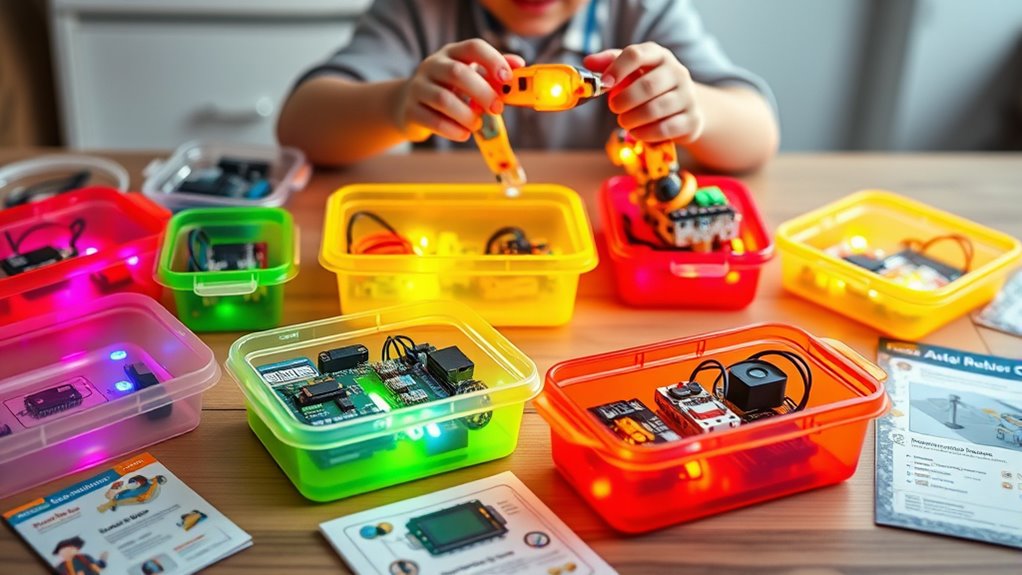
When selecting an educational STEM kit, I consider factors like age appropriateness and the quality of the content to ensure it’s both engaging and suitable. Safety features are also essential to protect kids during experiments, while building complexity and material durability affect how long the kit stays fun and useful. By keeping these points in mind, I can choose a kit that balances learning, safety, and durability effectively.
Age Appropriateness
Choosing the right STEM kit for your child starts with considering their age and developmental stage, making certain the activities match their motor skills and cognitive abilities. It’s vital to pick kits designed for specific age groups, like 4-8, 8-12, or 13+, so the complexity of projects aligns with their capabilities. Younger children need simpler instructions and fewer parts, while older kids can handle more advanced tasks. Safety features are essential—look for non-toxic materials and age-appropriate small parts. Always review manufacturer recommendations and warning labels to make sure the kit suits your child’s maturity level. Additionally, opt for kits with adjustable difficulty or expandability, so they can grow with your child and stay engaged over time.
Educational Content Quality
High-quality educational STEM kits stand out by offering clear, accurate, and age-appropriate content that aligns with current scientific standards and curricula. This ensures kids learn the right concepts at the right level. Thorough manuals, step-by-step instructions, and visual aids help make complex ideas understandable and reduce frustration during exploration. Well-designed kits include a variety of engaging projects that cover key STEM areas like circuitry, mechanics, renewable energy, and biology, keeping kids interested and challenged. Content that encourages critical thinking, problem-solving, and hands-on experimentation adds depth and lasting value to their learning experience. Reputable kits are often developed or endorsed by educational experts or institutions, which guarantees the scientific accuracy and reliability of the information, giving parents confidence in what their children are learning.
Safety Features Included
Safety features are a vital aspect to consider because they directly impact a child’s well-being during STEM activities. I always check that the kit uses non-toxic, BPA-free, and child-safe materials to minimize health risks. It’s also important that the components have shatterproof parts, rounded edges, and secure wiring to prevent injuries. Clear safety warnings and instructions tailored to specific age groups are essential for proper supervision. I look for kits with automatic shut-off or overheating protection on electronic parts, which add an extra layer of safety. Lastly, I ensure the product meets safety standards like ASTM, CE, or UL certifications, confirming it adheres to established safety guidelines. These features give me confidence that kids can explore and learn in a safe environment.
Building Complexity Level
When selecting an educational STEM kit, it’s important to take into account how the building complexity aligns with the child’s age and skill level. Consider whether the kit offers multiple difficulty levels or adjustable components that can grow with the child’s abilities. Check if the instructions are suitable for their experience—whether they’re beginners, intermediates, or advanced builders. Modular or expandable parts can also be a great feature, allowing projects to become more complex over time. Keep in mind that higher complexity kits may require adult supervision to ensure safety and help with assembly. Matching the complexity to the child’s developmental stage ensures they stay engaged, challenged, and motivated to learn while building confidence through successful projects.
Material Durability
Choosing a STEM kit that’s built to last is essential because durable materials guarantee the set can withstand frequent use and rough handling. High-quality plastics, metals, and wood ensure the kit remains intact after many adventures and experiments. I look for non-toxic, sturdy components that reduce breakage risks and keep play safe. Well-designed kits with reinforced joints and secure fittings prevent parts from snapping or loosening over time. If the materials are corrosion-resistant and weatherproof, I know the kit can be used outdoors or stored long-term without deterioration. Properly engineered materials also enhance safety, making sure small parts won’t break into sharp fragments. Overall, durability not only extends the lifespan of the kit but also ensures children can explore, learn, and experiment safely for years to come.
Expandability Options
A STEM kit’s ability to grow with a child’s interests and skills can make a significant difference in their learning journey. When choosing a kit, I look for modular components or expansion sets that can build on initial activities, offering new challenges as the child advances. Compatibility with other related kits or accessories is also key, as it opens doors to more complex projects without needing a complete overhaul. I check if supplementary parts or add-on kits are available, ensuring continued exploration beyond the basics. An ideal kit should support upgrades or customization, matching a child’s evolving skills and interests. Finally, I review the manufacturer’s expansion options, so I can confidently invest in a kit that encourages long-term growth and learning.
Ease of Assembly
Ensuring that a STEM kit is easy to assemble can make a big difference in a child’s learning experience. I recommend choosing kits with clearly labeled, color-coded, and numbered parts, which simplifies the process and helps kids follow instructions more confidently. Step-by-step guides with visual diagrams are also essential—they make building straightforward and reduce frustration. Modular components that snap or click together eliminate the need for tools or technical skills, encouraging independence. Organized storage trays or compartments are a plus, making part retrieval quick and effortless. Ultimately, selecting kits with age-appropriate complexity ensures the challenge is manageable, fostering a sense of accomplishment. When assembly is simple, kids stay engaged, learn more effectively, and develop a love for STEM activities.
Storage and Organization
Effective storage solutions are essential for keeping STEM kit components organized, accessible, and easy to use. Organized trays or labeled compartments help maintain neatness and make setup and cleanup straightforward. Compact packaging with designated spaces prevents parts from getting lost and helps kids find what they need quickly. Clear, compartmentalized containers are especially useful—they allow children to identify components instantly, reducing frustration and enhancing learning. Reusable storage cases encourage responsible organization habits and protect delicate parts for future projects. Proper storage not only streamlines the assembly process but also promotes independence, allowing kids to manage their kits confidently. Ultimately, well-organized STEM kits extend the lifespan of components and make the learning experience more enjoyable and less chaotic.
Frequently Asked Questions
How Do STEM Kits Support Different Age Groups and Learning Levels?
STEM kits support different age groups and learning levels by offering varying complexity and hands-on activities tailored to each stage. I love how younger kids can explore basic concepts with simple, colorful experiments, while older kids plunge into more challenging projects that foster critical thinking. These kits adapt to a child’s growth, making learning fun and engaging at every age. They truly encourage curiosity and skill development across all levels.
Are STEM Kits Suitable for Homeschooling or Classroom Settings?
Absolutely, STEM kits are perfect for both homeschooling and classroom settings. I’ve seen how they spark curiosity and make complex concepts accessible. Whether I’m teaching a group or guiding my child at home, these kits encourage hands-on learning and critical thinking. They’re versatile tools that fit seamlessly into lesson plans or individual study, making science, technology, engineering, and math engaging and fun for every age and learning style.
What Safety Precautions Should Parents Observe During Kit Activities?
I always make certain to read the safety instructions carefully before starting any STEM kit activity. I supervise my kids at all times, especially when handling small parts or tools. We wear safety goggles and gloves if needed, and I keep a first aid kit nearby. I also guarantee the workspace is clear of hazards and that kids understand the importance of following each step safely.
Can STEM Kits Be Reused or Expanded With Additional Projects?
STEM kits can absolutely be reused and expanded—think of them as a treasure trove of endless discovery! I’ve found that with a little creativity, you can add new projects or mix components for even more fun. Many kits come with extra parts or suggest modifications, so your child’s learning adventure doesn’t have to end after one use. Keep exploring, and your STEM kit can be a lifelong gateway to innovation!
How Do I Choose a STEM Kit Based on My Child’s Interests?
To select a STEM kit based on your child’s interests, I suggest observing what excites them most—whether it’s building, coding, or experimenting. Look for kits that align with those passions, offering projects they’ll enjoy. Check reviews to make certain they’re age-appropriate and engaging. Picking something that sparks their curiosity makes learning fun and keeps them motivated to explore more STEM topics.
Conclusion
Choosing the right STEM kit can truly ignite a child’s passion for learning—it’s like giving them a superpower for discovery! Whether they’re into robotics, earth science, or electronics, these kits make education exciting and hands-on. So, don’t wait—dive into these options and watch your kid’s curiosity skyrocket faster than a rocket to the stars. Trust me, this is one adventure they’ll never forget!

